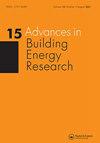Attic ventilation and radiant heat barriers in naturally ventilated galvanized metal-Roofed buildings
IF 2.5
Q2 CONSTRUCTION & BUILDING TECHNOLOGY
引用次数: 0
Abstract
ABSTRACT The study's uniqueness stems from its goal of determining the efficacy of natural attic vents and radiation heat barriers on galvanized metal roof buildings in lowering attic and indoor air temperatures for thermal comfort in a humid tropical climate, a topic that has received little attention in previous research. This was accomplished by utilizing three separate experimental situations using two tiny models of single-sloped zinc-roofed houses, each with varied attic ventilation openings and radiant heat barrier applications. The thermal conditions of the attic and occupant rooms in the ventilated test cell tended to be cooler than in the unventilated one in the first experiment, which compared a test cell with 20% ventilation apertures in the attic to another test cell without ventilation. The second experiment, which compared a test cell with 10% attic ventilation to another test cell (without attic ventilation) with radiant heat barrier application, found that the radiant heat barrier's effect on temperature reduction was generally better. The third experiment, which compared a test cell with 20% attic ventilation to a test cell without attic ventilation but with radiant heat barrier application, revealed that attic ventilation outperformed the radiant heat barrier in terms of temperature reduction.自然通风镀锌金属屋面建筑的阁楼通风和辐射热障
摘要本研究的独特性源于其目标,即确定镀锌金属屋顶建筑的天然阁楼通风口和辐射隔热层在潮湿热带气候下降低阁楼和室内空气温度以获得热舒适性的效果,而这一主题在以前的研究中很少受到关注。这是通过利用三种不同的实验情况实现的,使用了两个小型的单倾斜锌屋顶房屋模型,每个模型都有不同的阁楼通风口和辐射隔热应用。在第一个实验中,通风试验室的阁楼和居住室的热条件往往比不通风试验室更冷,该实验将阁楼上有20%通风孔的试验室与另一个没有通风的试验室进行了比较。第二个实验将阁楼通风量为10%的试验室与应用辐射隔热的另一个试验室(没有阁楼通风)进行了比较,发现辐射隔热的降温效果通常更好。第三个实验将阁楼通风量为20%的试验室与没有阁楼通风但应用了辐射热障的试验室进行了比较,结果表明阁楼通风在降低温度方面优于辐射热障。
本文章由计算机程序翻译,如有差异,请以英文原文为准。
求助全文
约1分钟内获得全文
求助全文
来源期刊

Advances in Building Energy Research
CONSTRUCTION & BUILDING TECHNOLOGY-
CiteScore
4.80
自引率
5.00%
发文量
11
 求助内容:
求助内容: 应助结果提醒方式:
应助结果提醒方式:


